 Website:
MECALUX
Website:
MECALUX
Group: Mecalux
Catalog excerpts

Conventional Pallet Racking A universal system for direct access to each pallet
Open the catalog to page 1
General Features of Conventional Pallet Racking Mecalux’s conventional pallet racking is the best solution for warehouses with a wide range of SKUs that need to be stored on pallets. Key advantages - Goods can be easily retrieved as each pallet can be accessed without shifting other pallets. - Total stock control since each storage location holds a single pallet. A conventional pallet rack warehouse is generally arranged with single-entry racks on either side and double-entry racks down the middle. The type of forklifts or handling equipment used and the height of the warehouse determine...
Open the catalog to page 2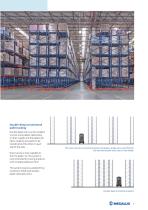
Double-deep conventional pallet racking Double-deep racks can be installed to store more pallets (depending on their weight and the pallets per SKU), enabling one pallet to be stored behind the other on each side of the aisle. Direct access is only available to the first pallet. So, this system is recommended for storing products with multiple pallets per SKU. The most common conventional system comprises a single-entry rack fitted to the wall and double-entry racks in the middle This system requires suitable lifting machinery fitted with doubledepth telescopic forks. Double-deep...
Open the catalog to page 3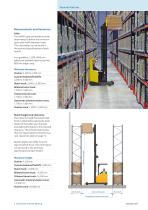
General features Measurements and clearances Aisle The forklift type and model must be determined to define the minimum open aisle width between loads. This information can be found in the technical specifications of each forklift. As a guideline, 1,200 x 800 mm pallets are handled sidewise by their 800 mm edge using: Minimum clearances: Stacker: 2,200 to 2,300 mm Counter-balanced forklift: 3,200 to 3,500 mm Reach truck: 2,600 to 2,900 mm Bilateral turret truck: 1,500 to 1,600 mm Trilateral turret truck: 1,700 to 1,900 mm Automatic trilateral stacker crane: 1,700 to 1,900 mm Stacker crane:...
Open the catalog to page 4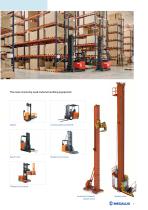
The most commonly used material handling equipment: Counter-balanced forklift Reach truck Bilateral turret truck Trilateral turret truck Automatic trilateral stacker crane Stacker crane
Open the catalog to page 5
General features The above image shows a pallet racking warehouse, with pallets handled by their 1,200 mm edge Conventional pallet racking warehouse. Pallets handled sidewise along their 800 mm edge Load units: pallets and containers Goods are placed on pallets and in containers when stored. The characteristics of the goods determine the way they should be stored. The most common types are: Europallets Europallets are 800 x 1,200 mm in size and handled sidewise by their shorter edge. Pallets are also made with the same criteria in measurements of 1,000 x 1,200 mm and 1,200 x 1,200 mm....
Open the catalog to page 6
Conventional pallet rack warehouse with metal containers Europallets (800 x 1,200 mm) are normally handled sidewise by the short edge, since they have three skids running along the base parallel to the 1,200 mm lengthwise edge. When stored on the racks, these skids rest perpendicular to the support beams. Containers Storage containers are usually made of metal and are built with variable specifications and sizes. They may require additional components to be used for storage on conventional pallet racking. Other pallets and containers In addition to the previously mentioned types, other...
Open the catalog to page 7
Basics components Basic components Mecalux has developed an extensive range of accessories to help store goods on pallets, no matter how demanding your storage needs may be. Components 1. Frame (page 10) 2. Beam (page 16) 19 3. Safety locking mechanism (page 18) 1 4. Row spacer (page 18) 5. Anchor bolts (page 11) 6. Levelling shims (page 11) 7. Upright protector (page 25) 18 8. Lateral protection barrier (page 24) 9. Cross bracing set (page 32) 10.Top portal tie (page 40) 11. Pallet support bar (page 26) 12. Container support bar (page 27) 13. Chipboard deck support (page 22) 14.Chipboard...
Open the catalog to page 8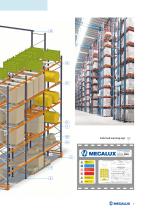
Safe load warning sign 22
Open the catalog to page 9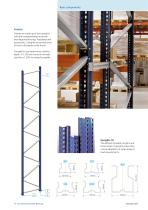
Basic components Frames Frames are made up of two uprights with the corresponding horizontal and diagonal bracings, footplates and accessories. Uprights are slotted every 50 mm to fit beams to the frame. The pallet’s size determines a frame's depth. A 1,100 mm frame is normally used for a 1,200 mm deep Europallet. Uprights (1) The different models, lengths and thicknesses of uprights mean they can be adapted to a wide range of load requirements. 10 Conventional Pallet Racking
Open the catalog to page 10
Frame footplates (2) Frames are erected on the floor using footplates, which are fitted to the base of the uprights. A wide range of different frame footplates are used depending on the load required and the upright model used. One or two anchor bolts fix them to the floor. Levelling shims (3) Shims level out racks set up on uneven slabs. Each type of upright has its own type of shim, which comes in different thicknesses for more a precise levelling. Anchor bolts (4) Racks are fixed to the slab using anchor bolts. They vary depending on the forces they must withstand and the characteristics...
Open the catalog to page 11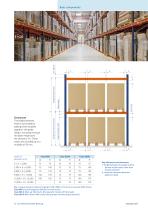
Basic components Height from floor to 1st level Clearances The height between levels is calculated by adding three variables together: the pallet height, including the load, the beam height and the clearance (Y). These values are rounded up to a multiple of 50 mm. Beam height Height of pallet + load Height between levels Bay tolerances and clearances: Y: height between the pallet and the bottom of the beam, other than the ground level. X: minimum clearance between pallets or loads. Bay or space clearance table according to UNE 15620, in force since January 2009, where: Class 400:...
Open the catalog to page 12
Handled sidewise Beams measured in mm (up to 9,000 mm high) Pallet Beam Handled lengthwise Beams measured in mm (up to 9,000 mm high) Pallet Beam Frame depths (mm) Pallets handled sidewise Pallet sizes Pallets handled lengthwise
Open the catalog to page 13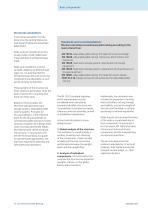
Basic components Structural calculations A structural calculation must be done once the racking tolerances, buckling and clearances have been determined. Pallet racks are metallic structures, usually made of cold-rolled sheet metal and able to withstand heavy loads. Pallet rack installations must be versatile, adapting to different load types. So, it is essential that the fittings between the main structural components are adjustable, as well as fast and easy to assemble. These uprights of the structure are often slotted or perforated, while the beams have built-in couplings that hook into...
Open the catalog to page 14All MECALUX catalogs and technical brochures
-
Conveyor systems for boxes
48 Pages
-
Pallet conveyor systems
64 Pages
-
Automated warehouses
120 Pages
-
Wire mesh partitions & cages
8 Pages
-
Mezzanines
20 Pages
-
Cantilever Racking
24 Pages
-
Metal Point Boltless Shelving
24 Pages
-
Racking for Live Picking
36 Pages
-
M3 Shelving for picking
36 Pages
-
M7 Longspan shelving
31 Pages
-
Push-back pallet racking
12 Pages
-
Live Pallet Racking
28 Pages
-
Pallet Shuttle
36 Pages
-
Movirack Mobile Pallet Racking
20 Pages
-
Drive-in Pallet Racking
32 Pages




















